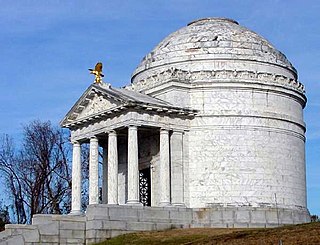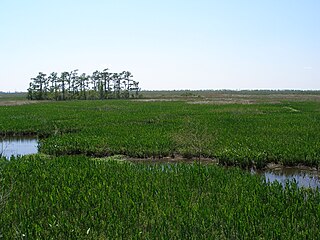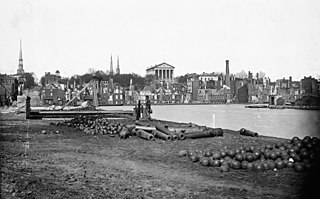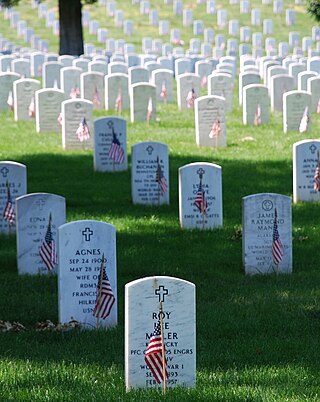
The Battle of Brice's Cross Roads, also known as the Battle of Tishomingo Creek or the Battle of Guntown, was fought on Friday, June 10, 1864, near Baldwyn, Mississippi, then part of the Confederate States of America. A Federal expedition from Memphis, Tennessee, of 4,800 infantry and 3,300 cavalry, under the command of Brigadier-General Samuel D. Sturgis, was defeated by a Confederate force of 3,500 cavalry under the command of Major-General Nathan B. Forrest. The battle was a victory for the Confederates. Forrest inflicted heavy casualties on the Federal force and captured more than 1,600 prisoners of war, 18 artillery pieces, and wagons loaded with supplies. Once Sturgis reached Memphis, he asked to be relieved of his command.

The Battle of Palmito Ranch, also known as the Battle of Palmito Hill, is considered by some criteria as the final battle of the American Civil War. It was fought May 12 and 13, 1865, on the banks of the Rio Grande east of Brownsville, Texas, and a few miles from the seaport of Los Brazos de Santiago, at the southern tip of Texas. The battle took place more than a month after the general surrender of Confederate forces to Union forces at Appomattox Court House, which had since been communicated to both commanders at Palmito, and in the intervening weeks the Confederacy had collapsed entirely, so it could also be classified as a postwar action.

James Munro McPherson is an American Civil War historian, and is the George Henry Davis '86 Professor Emeritus of United States History at Princeton University. He received the 1989 Pulitzer Prize for Battle Cry of Freedom: The Civil War Era. McPherson was the president of the American Historical Association in 2003.

The Lost Cause of the Confederacy is an American pseudohistorical negationist mythology that claims the cause of the Confederate States during the American Civil War was just, heroic, and not centered on slavery. First enunciated in 1866, it has continued to influence racism, gender roles and religious attitudes in the South to the present day.

Ox Hill Battlefield Park is a site in Fairfax, Virginia, where the Battle of Ox Hill was fought during the American Civil War. It was the only major battle of the war fought in Fairfax County. The battlefield is now a public park adjacent to suburban developments and the Fairfax Towne Center shopping center, and is maintained by the Fairfax County Park Authority.
The most common name for the American Civil War in modern American usage is simply "The Civil War". Although rarely used during the war, the term "War Between the States" became widespread afterward in the Southern United States. During and immediately after the war, Northern historians often used the terms "War of the Rebellion" and "Great Rebellion", and the Confederate term was "War for Southern Independence", which regained some currency in the 20th century but has again fallen out of use. The name "Slaveholders' Rebellion" was used by Frederick Douglass and appears in newspaper articles. "Freedom War" is used to celebrate the war's effect of ending slavery.

National Military Park, National Battlefield, National Battlefield Park, and National Battlefield Site are four designations for 25 battle sites preserved by the United States federal government because of their national importance. The designation applies to "sites where historic battles were fought on American soil during the armed conflicts that shaped the growth and development of the United States...."

Jean Lafitte National Historical Park and Preserve protects the natural and cultural resources of Louisiana's Mississippi River Delta region. It is named after French pirate Jean Lafitte and consists of six separate sites and a park headquarters.
The American Battlefield Trust is a charitable organization whose primary focus is in the preservation of battlefields of the American Civil War, the Revolutionary War and the War of 1812 through acquisition of battlefield land. The American Battlefield Trust was formerly known as the Civil War Trust. On May 8, 2018, the organization announced the creation of the American Battlefield Trust as the umbrella organization for two divisions, the Civil War Trust and the Revolutionary War Trust, which was formerly known as "Campaign 1776."
Guilford Courthouse National Military Park, at 2332 New Garden Road in Greensboro, Guilford County, North Carolina, commemorates the Battle of Guilford Court House, fought on March 15, 1781. This battle opened the campaign that led to American victory in the Revolutionary War. The loss by the British in this battle contributed to their surrender at Yorktown seven months later. The battlefield is preserved as a National Military Park and operated by the National Park Service (NPS). Based on research of historical evidence, the interpretation of the battle has changed since the late 20th century, which will affect the placement of monuments and markers.

Chalmette National Cemetery is a United States National Cemetery located within Jean Lafitte National Historical Park and Preserve in Chalmette, Louisiana. The cemetery is a 17.5-acre (7.1 ha) graveyard adjacent to the site that was once the battleground of the Battle of New Orleans, which took place at the end of the War of 1812. Despite its proximity to the site of the Battle of New Orleans in the War of 1812, the majority of the interments are of soldiers who were casualties or veterans of the American Civil War, the Spanish-American War, World War I, World War II, the Korean War, or the Vietnam War. The cemetery was subsequently closed to new interments.

During the American Civil War, the Commonwealth of Pennsylvania played a critical role in the Union, providing a substantial supply of military personnel, equipment, and leadership to the Federal government. The state raised over 360,000 soldiers for the Federal armies. It served as a significant source of artillery guns, small arms, ammunition, armor for the new revolutionary style of ironclad types of gunboats for the rapidly expanding United States Navy, and food supplies. The Phoenixville Iron Company by itself produced well over 1,000 cannons, and the Frankford Arsenal was a major supply depot.

Richmond, Virginia served as the capital of the Confederate States of America for almost the whole of the American Civil War. Notwithstanding its political status, it was a vital source of weapons and supplies for the war effort, as well as the terminus of five railroads, and as such would have been defended by the Confederate States Army at all costs.
The American Battlefield Protection Program (ABPP) is a United States federal government program created by the Secretary of the Interior in 1991, with the aim of preserving historic battlefields in the United States. In 1996, Congress signed into law the American Battlefield Protection Act, which officially authorized the ABPP. The program operates under the American Battlefield Protection Program Authorization as of 2009.

Since 1872 the United States National Park System has grown from a single, public reservation called Yellowstone National Park to include 430 natural, historical, recreational, and cultural areas throughout the United States, its territories, and island possessions. These areas include National Parks, National Monuments, National Memorials, National Military Parks, National Historic Sites, National Parkways, National Recreation Areas, National Seashores, National Scenic Riverways, and National Scenic Trails.

Birch Coulee Battlefield in Renville County, Minnesota, United States, was the site of the Battle of Birch Coulee, the costliest military engagement for U.S. forces during the Dakota War of 1862. It is now a historic site with self-guided trails and markers interpreting the battle from both sides. Birch Coulee was nominated to the National Register of Historic Places for having state-level significance in military history, and was listed in 1973.
The American Civil War Centennial was the official United States commemoration of the American Civil War, also known as the War Between the States. Commemoration activities began in 1957, four years prior to the 100th anniversary of the commencement of hostilities, and ended in 1965 with the 100th anniversary of the surrender at Appomattox.

The commemoration of the American Civil War is based on the memories of the Civil War that Americans have shaped according to their political, social and cultural circumstances and needs, starting with the Gettysburg Address and the dedication of the Gettysburg cemetery in 1863. Confederates, both veterans and women, were especially active in forging the myth of the Lost Cause of the Confederacy.
The Civil War Trust's Civil War Discovery Trail is a heritage tourism program that links more than 600 U.S. Civil War sites in more than 30 states. The program is one of the White House Millennium Council's sixteen flagship National Millennium Trails. Sites on the trail include battlefields, museums, historic sites, forts and cemeteries.















